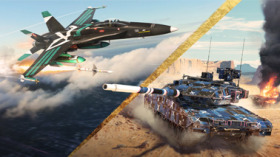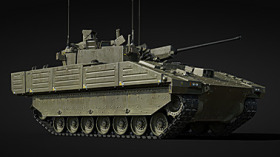
- Для PC
- Для Mac
- Для Linux
- ОС: Windows 10 (64 bit)
- Процессор: Dual-Core 2.2 GHz
- Оперативная память: 4 ГБ
- Видеокарта с поддержкой DirectX версии 11: AMD Radeon 77XX / NVIDIA GeForce GTX 660. Минимальное поддерживаемое разрешение – 720p.
- Сеть: Широкополосное подключение к Интернету
- Место на жестком диске: 22.1 Гб
- ОС: Windows 10/11 (64bit)
- Процессор: Intel Core i5 или Ryzen 5 3600 и выше
- Оперативная память: 16 ГБ
- Видеокарта с поддержкой DirectX 11 и выше: Nvidia GeForce 1060 и выше, Radeon RX 570 и выше
- Сеть: Широкополосное подключение к Интернету
- Место на жестком диске: 62.2 Гб
- Операционная система: Mac OS Big Sur 11.0
- Процессор: Core i5, минимум 2.2GHz (Intel Xeon не поддерживается)
- Оперативная память: 6 Гб
- Видеокарта: Intel Iris Pro 5200 (Mac) или аналогичная видеокарта AMD/Nvidia для Mac (минимальное поддерживаемое разрешение – 720p) с поддержкой Metal
- Место на жестком диске: 22.1 Гб
- Операционная система: Mac OS Big Sur 11.0
- Процессор: Intel Core i7 (Intel Xeon не поддерживается)
- Оперативная память: 8 Гб
- Видеокарта: Radeon Vega II и выше с поддержкой Metal
- Место на жестком диске: 62.2 Гб
- Операционная система: Современные дистрибутивы Linux 64bit
- Процессор: Dual-Core 2.4 ГГц
- Оперативная память: 4 Гб
- Видеокарта: NVIDIA GeForce 660 со свежими проприетарными драйверами (не старее 6 месяцев) / соответствующая серия AMD Radeon со свежими проприетарными драйверами (не старее 6 месяцев, минимальное поддерживаемое разрешение - 720p) с поддержкой Vulkan
- Место на жестком диске: 22.1 Гб
- Операционная система: Ubuntu 20.04 64bit
- Процессор: Intel Core i7
- Оперативная память: 16 Гб
- Видеокарта: NVIDIA GeForce 1060 со свежими проприетарными драйверами (не старее 6 месяцев) / Radeon RX 570 со свежими проприетарными драйверами (не старее 6 месяцев) с поддержкой Vulkan
- Место на жестком диске: 62.2 Гб
/shot%202015_08_12%2015_21_53.jpg)
Light Tank M2A4 in summer camouflage from 1st Armored Division in War Thunder.
The origins of the 1st Armored Division of the US Army can be traced back to two Cavalry units - the 1st Cavalry Regiment and the 7th Cavalry Brigade. In the 1930s, both those units were slowly changing their horses for trucks, jeeps and armored cars. The experiences of World War I also played a part in the growth of both units, as the US Army was experimenting with tactics that would enable them to avoid engaging in static trench warfare. The German offensives on Poland in September 1939 and in France in May 1940 highlighted the importance of a new type of unit - the Armored Division. In June 1940 the orders were given to create such units. The 1st Armored Division was officially established on July 15th 1940, with Major General Bruce Magruder assuming command. Soon it was given the nickname of “Old Ironsides” as a reference to the US Navy frigate USS Constitution. Training of new recruits quickly commenced and soon the division grew from 66 to over 600 vehicles. At the time it was stationed at Fort Knox, which was also the headquarters for the newly created Armor Branch.
/1st_Armored_Division_Tank,_World_War_II.jpg) |
| The M5A1 Stuart Tank, used by Iron Soldiers in World War II. |
Until 1942 the Division spent its time in the US training and preparing themselves for battle. It came soon, as it was attached to the US forces taking part in Operation “Torch” - amphibious landings in Oran, Algiers and Casablanca intended to pincer the German Afrika Korps and the Italian forces in Tunisia. After securing the beachheads the Allies moved towards Tunisia; however their advance was slowed down by stiff Axis resistance. It was then that the lack of combat experience of American troops was becoming visible. The evidence was seen in 1943 when a German counter offensive near the Kasserine Pass decimated the 1st Armored Division, causing them to lose a lot of men and material. This costly lesson proved valuable in the future, as the Americans quickly started adapting their tactics to the ever changing battlefield.
Following the surrender of the Panzerarmee Afrika in May 1943 the 1st Armored Division was attached to the 5th Army commanded by General Mark Clark. After the success of the Allied landings on Sicily the next step was the invasion on the Italian mainland. The 1st Armored found itself in the thick of battle in September 1943 after amphibious landings around the city of Salerno. Breaking out of the beachhead, the Division formed the spearhead of the allied assault on Naples which was captured in October. After that the allies continued the advance northwards towards the Volturno river; however soon the attacks were stalled by German defences centered around the town of Cassino, known as the “Winter Line”.
Allied commanders then decided to land troops behind those lines near Anzio, which would allow them to capture Rome and cut off supplies to Axis defenders. The landings on the Anzio beachhead commenced in January 1944. However, due to the indecision of the Allied commander General John P. Lucas, the Germans were able to quickly isolate the beachhead. The 1st Armored did not take part in the first wave of the landings, but it was deployed later on in an effort to strengthen the Allied positions. It also led the breakthrough from the beachhead in May 1944 and reached Rome on June 4th 1944. After the capture of Rome it pursued the Germans to the north and ended the war in the Po Valley in May 1945. The Division was deactivated in 1946 but it was reinstated in 1951. After a long stay in Fort Hood, Texas, the division was redeployed to West Germany in place of the 4th Armored Division as part of the US Forces in Europe.
After the fall of communism in Europe, the Division took part in conflicts such as the Gulf War, Operation Joint Endeavor in Bosnia and in the conflicts in Afghanistan and Iraq. Currently the Division resides in Fort Bliss, Texas, after being pulled out from Germany in 2011.
Author: Adam “BONKERS” Lisiewicz
In one of the following Updates, we will include decals of 1st Cavalry Regiment, 13th Cavalry Regiment and text "Foxhunter" to War Thunder:
/usa_1st_cavalry_regiment.png) |
/usa_13th_cavalry_regiment.png) |
/usa_text_foxhunter_transparent.png) |



